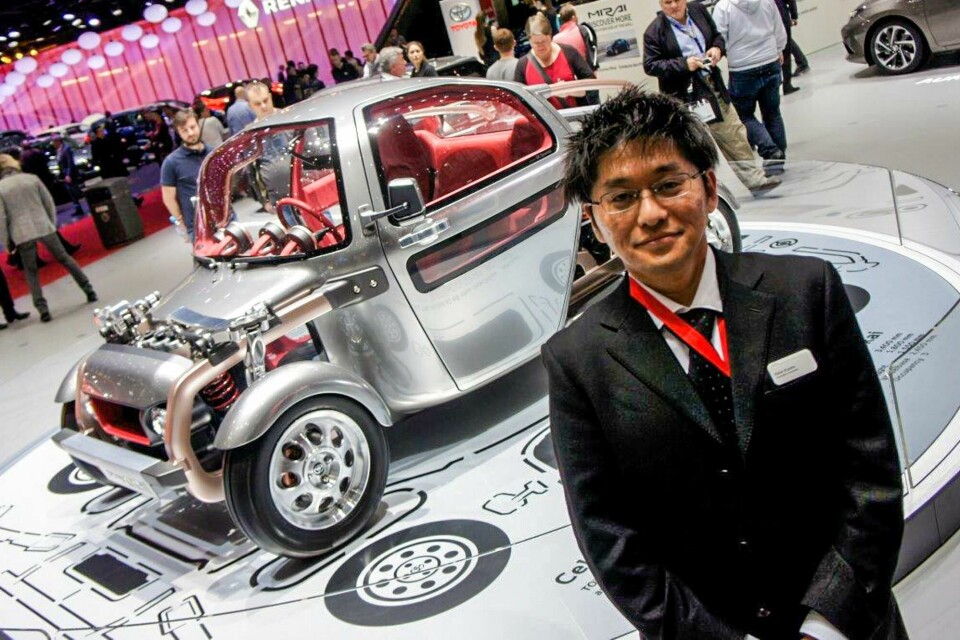
Designer Interview: Kazuo Suyama, Toyota Kikai project manager
Getting under the skin of Toyota’s sci-fi, steampunk show car
Back in 2008, Toyota established Toyota Design Intersection, a trend-spotting design office in Tokyo’s Shibuya district, not far from Nissan’s Creative Box, a studio set up nearly 30 years ago. Both share the same basic purpose: to foster disruptive design.
Before the Tokyo studio was set up, Toyota had begun sending its talented young designers to American schools to learn new ways of thinking. Results of the scheme include current Lexus chief designer Tadao Mori, who spent time under Carl Olsen at CCS in Detroit 15 years ago as part of this programme.
It’s therefore interesting to ask Kazuo Suyama, who works in the Design Intersection studio, if this satellite facility – so far removed from corporate Toyota City and the main design centre – is populated with people of similar backgrounds and global education.

“I’m neither an engineer, nor a designer, I’m only a physicist” he said, excusing himself for not having heard of such a programme. However, it also doesn’t take long to realise that Suyama doesn’t need to travel anywhere else to be encouraged to think freely. What’s more, he is incredibly animated when talking about his creation, the Kikai show car that debuted at the Tokyo show last year. In fact, he’s more like an excited Italian, completely subverting expectations of Japanese designers, who are usually some of the more reserved interview subjects.

Kazuo Suyama’s job title is ‘assistant manager for the Mirai project department, product and business planning division’ – here Mirai means ‘future’ in Japanese, rather than the hydrogen-powered sedan. You wouldn’t believe someone with such a title could come up with something like the Kikai, a kind of Ariel Atom, but much more urban, hip and even sci-fi.

“My team wanted to create a new vehicle category,” says Suyama. “We’d like to show that a car is much more than just transport, and also that the future is not only hydrogen. We wanted to show the beauty of the mechanics and at the same time remind everyone of Toyota’s heritage based, as we are, on looms and machinery. We obviously want to speak to the youth. Not very interested in cars maybe, but we want to address their respect for the environment, how they embrace organic food, their return back to tactile sensations.”

He cites trends like increasing sales of vinyl records and the example of how the Blue Bottle Coffee café in San Francisco (and Shibuya) prepares its brews to illustrate his point. “There is a wish to experience the excitement of motion and it seems we still have a need to know what objects are really like,” he continues. “Cloud-based, black boxes, too much AI and virtuality – I think elements of the Kikai (which means Machinery in Japanese) – will be attractive, maybe even strangely addictive again, to young people.”

The Kikai itself is 3400mm long, 1800mm wide and 1550mm tall, and sits somewhere between a hot rod and a Renault Twizy with attitude. The exterior is like Paris’s Pompidou Centre on four wheels, with all the important parts – suspension arms, fuel tank, exhaust pipes, braking system, all made with exquisite craftsmanship – in full view. There’s no word on its powertrain, but the aesthetics certainly indicate a piston engine in the rear. Inside, there’s seating for three, with the driver in the centre. The instruments are conspicuously analogue, and – importantly – there are no infotainment screens.

Suyama’s team never expected the project to be approved, but his team developed the idea, made a complete business plan, presented it to the management and got the go ahead, surprising even them. “But that’s very important when you live in the middle of innovative studies, to be able to present and discuss them once in a while.”

Suyama’s graph – proof that he’s more physicist than designer!
As he says this, he grabs a pen to draw a rough graph of what he means by being ‘in the middle’ with creativity. “You have a very steep sine-like curve starting with zero creativity at the ‘logical’ end of the X-axis, and ending with zero at the ‘impulsive’ end, but culminating at maximum creativity in the middle, between the two.”
This illustrates where he and his team at Toyota’s Design Intersection studio operate, and how the unique approach yields results like the Kikai. And despite his earlier statement that he’s “a physicist,” rather than a designer, there’s nothing more typical a trait for a creative, visual thinker – regardless of training – than not being able to explain without a sketch now and then.



